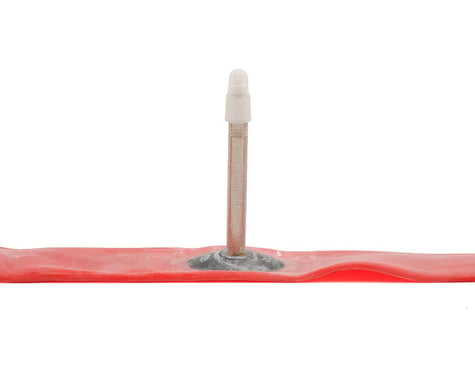This is a Challenge Latex Tube for road/ Cyclocross 700c tires between 28 and 35mm widths. For race day supremacy, latex tubes are quickly becoming a popular choice due to vast reduction in rotational weight. Weight weenies, rejoice!
Why use a latex tube?
Tubes made out of latex are more elastic than normal butyl tubes. This makes them roll a little more easily. Their greatest advantage lies in the high level of puncture protection. The highly elastic latex material is very difficult to puncture.
The disadvantage lies in poor air retention. A tire with a latex tube must be adjusted for inflation pressure before every trip. This explains why latex tubes are not well suited for everyday use.
Features:
- Seamless latex
- 47mm removable core valve
Heat and UV light are very bad for latex, so where the tubes were stored could be a big factor. Latex tubes deteriorate only if outside and exposed to light, sun, UV and extreme temperatures. There are tubulars that are 20 years old and still run great, so the tube has a long life when protected.
Problems are also caused by inserting the tubes (usually in a hurry) either under inflated, over inflated or when the talc we pre-apply is wiped off, then pushing the tube into the tire with a twist. The twist in the inner tube, when inflated to high pressure, creases the inner tube, making the tube prone to failure at the focus of the twist.
The keys during installation are:
1. lightly inflating the tube exactly to the point where it first forms its toroidal shape with no extra pressure;
2. making sure the tube is covered in talc so it slides through your hand (and inside the tire) and is not sticky;
3. as you press the second bead of the tire into the rim, make sure the latex inner tube is inserted into the tire cradle (away from the tire rim interface) and is NOT twisted;
4. when you get to the point where you are pushing the last bit of the second bead onto the rim, if the tube is trying to escape the tire, reduce the air pressure a bit until the tube can be pushed up into the tire and away from the tire/rim interface;
5. when you get the tire fully seated, inflate the tire to about 2 bar (25-30 psi), remove the pump and gently rock the tire back and forth through its entire radius to make sure the tire is truly seated and the inner tube is not pinched between the tire and rim somewhere; and
6. finally, fully inflate the inner tube.
For riders pairing Open Tubulars with a latex tube and aren’t experienced at mounting them, get a few rides on the Open Tubular with a butyl tube before installing the latex one so the tire can take shape and the installation is easier than with the flat tire.
My bottom line on latex tubes? They perform incredibly well if stored and installed properly. However, it is incredibly difficult to impress on the average consumer (and sometimes even mechanics) that you must sacrifice a bit of extra time and effort while installing them to ensure they perform their extraordinary deeds and live a long and healthy life inside their tire/rim cradle.
All of this explains why we have virtually zero problems with latex inner tubes in our tens of thousands of tubular tires sold every year. Once they are safely sewn into their nice, comfy cradles they do wonderful things and live a long and vibrant life.
— Morgan Nicol
Challenge Handmade Tires
Specifications:
Diameter: 700c
ISO Diameter (ETRTO): 622
Valve Type: Presta
Valve Length: 47mm
Removable Valve Core: Yes
Puncture Protection: -
Weight: 62g
This product was added to our catalog on March 7, 2018


